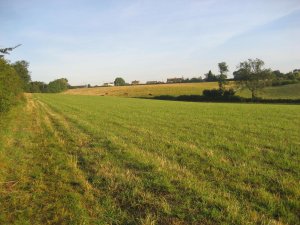It is suddenly time to be thinking about hay making. We need the rain and some good, warm sunshine to get as much bulk into the grass as possible. Then a long spell of dry and hot to get it cut and baled. Our grass is, from the hay point of view, none too brilliant. As most of it is in the Countryside Stewardship Scheme, we can’t enrich it with the nitrogen it needs to become the deep, lush, green of a cow’s dream. In return for this lowering of soil nitrogen and consequent reduction in productivity, we try to maintain our excitement at the mix of flowers, grasses and invertebrates that are appearing.
As the soil becomes poorer, the grasses that would dominate in richer soils, can’t maintain their bullying ways. Other more timid plants notice the space and begin to make their presence felt. Selfheal, Prunella vulgaris and knapweed, Centaurea nigra will soon flower, adding some purple to the mix. The latter, also known as ‘hardheads’ has a composite flower head that never opens fully like those of its greater knapweed cousins. For several of the summer months they are ideal for whacking younger brothers.
A variety of clovers has moved in en masse. These are led by the wild white Trifolium repens, supplemented by more exotic varieties of the same as well as weedier members of the pea tribe – particularly common birds foot trefoil, Lotus corniculatus and black medick, Medicago lupulina. These in theory will bring their own nitrogen-fixing root nodule-based fungi which pinch atmospheric nitrogen and make it available to the plant. The surrounding grasses should also benefit.
Last Saturday was very warm. There were large numbers of common blue butterflies, Polyommatus icarus, zooming around the developing hay crop, refusing to settle and thus being tricky to observe. Jane mentioned having seen a common spotted orchid, Dactylorhiza fuchsii, in flower in Bottoms’ Corner. Fortunately I avoided cutting it whilst mowing rides in the wood today. Unable to resist the temptation to have a bit of a mooch around, I found the orchid and at the flower spike’s tip, perched upside down was a common blue, wings folded; motionless. Today, being ten degrees cooler than Saturday, this butterfly clearly hadn’t the energy necessary to get airborne. After a few minutes looking through some flowering grasses nearby I found three more, all doing a passable impression of grass seed heads. As I watched, the sun came out and the temperature increased sharply. Two of the butterflies spread their wings, briefly soaking up the rays before taking to the air and becoming as difficult to follow as they had been on Saturday. I was annoyed that I had not picked up a camera this morning so I have to hope another chance presents itself soon.
It’s not surprising really that I’m always so behind in the farm work I try to do.


